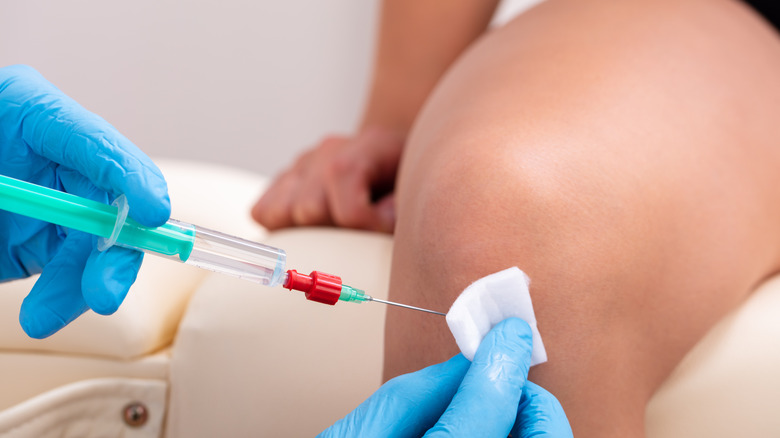Read This Before Getting A Cortisone Shot
Corticosteroid injections have long been a staple in the management of symptoms of osteoarthritis, rheumatoid arthritis, bursitis, and other joint diseases. While there are over 100 forms of arthritis, osteoarthritis is the most common, and it is one of the most common reasons people receive cortisone injections into their joints (via Centers for Disease Control and Prevention).
Treatment for osteoarthritis and other joint diseases may consist of some variation of the following; weight loss, physical therapy, over-the-counter or prescription anti-inflammatories, cortisone or "gel" joint injections, and/or surgery. Corticosteroid injections can provide quick relief of joint pain and help decrease inflammation.
The injections are typically performed right in your doctor's office. Your medical provider will first position the joint to be injected at the proper angle and clean the area. Then they may apply a numbing spray before injecting cortisone into the right place. Some practices even use an ultrasound machine to ensure the needle is going exactly where it's supposed to. Cortisone injections are considered non-invasive and should be considered prior to surgical interventions, but there are a few things you should know before getting your shot.
Receiving cortisone shots too often can actually do more damage
While cortisone injections may seem like a quick fix, they are not without risk. While most people won't experience significant side effects, some discomfort at the injection site can occur. However, any redness, swelling, or increasing pain at the site may be a sign of infection, and should be reported to your healthcare provider immediately (via Mayo Clinic). Temporarily, cortisone injections can also cause blood sugar levels to rise, something that should be monitored, particularly in diabetic patients. Facial flushing can occur as well.
It is important to note that repeated cortisone injections into the same joint may actually be detrimental to the joint's integrity. Receiving too many cortisone injection in close proximity could lead to cartilage damage and sometimes even osteonecrosis, or death of nearby bone. Loss or thinning of the bones may also occur, leaving you more susceptible to fractures.
Despite being a staple in joint management, a new study published in the New England Journal of Medicine last year actually revealed interesting results about cortisone injections. The study included 156 people, with 78 patients undergoing physical therapy and 78 patients receiving cortisone injections to address their knee pain. After one year, they found that people who participated in physical therapy experienced less pain and "functional disability" compared to those who received cortisone injections.
To determine if cortisone injections are the right treatment for you, be sure to speak with your healthcare providers, particularly orthopedists or rheumatologists, who specialize in disorders of the joints and bones.


